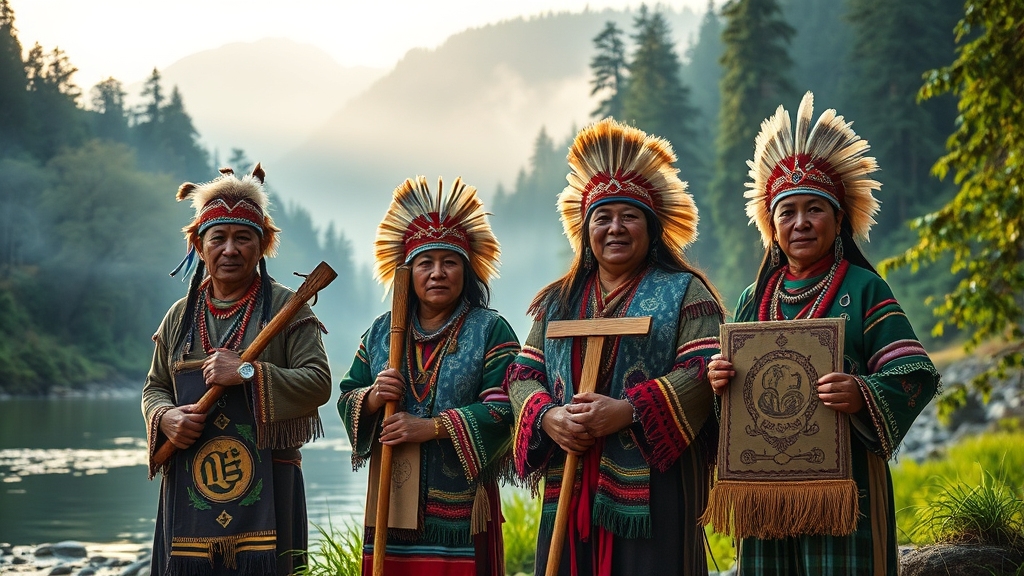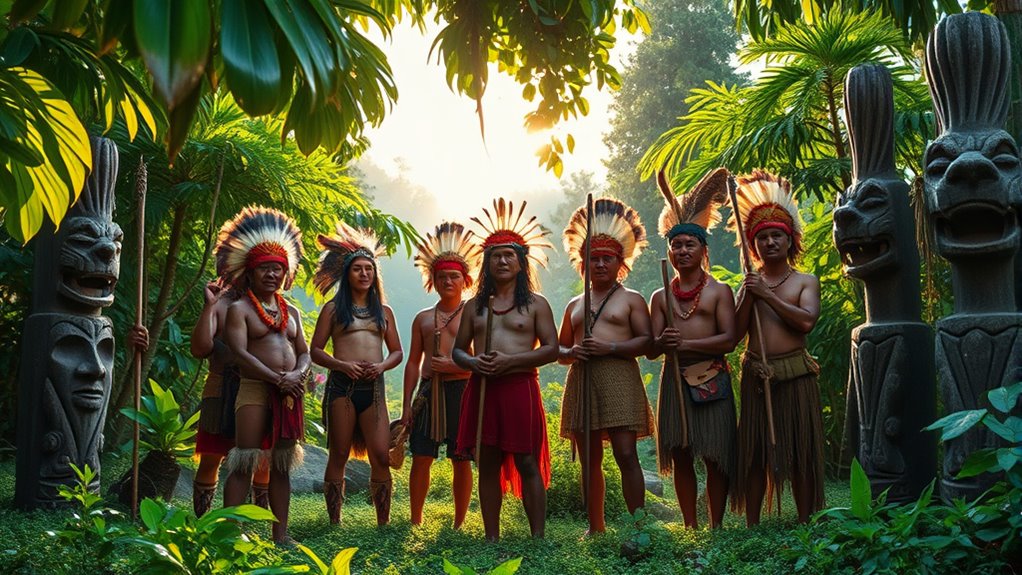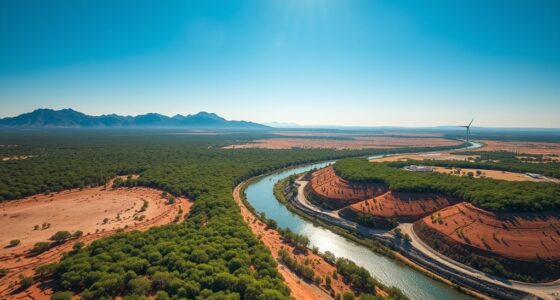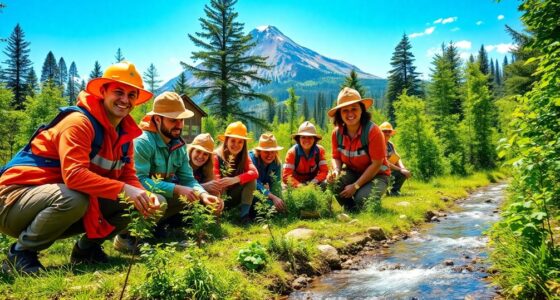You can see that native communities lead conservation by applying their centuries-old cultural practices, traditional knowledge, and spiritual connections to protect land and ecosystems. They actively patrol sacred sites, monitor wildlife, and resist destructive industries, all rooted in a deep relationship with nature. Their leadership demonstrates that conservation is a cultural commitment built on generations of experience. Keep exploring how these community efforts are shaping a more sustainable future for the planet.
Key Takeaways
- Indigenous communities view land as sacred, integrating cultural rituals and spirituality into conservation efforts.
- Traditional knowledge guides sustainable resource harvesting and ecological management, often outperforming external scientific methods.
- Indigenous leaders proactively monitor ecosystems, protect sacred sites, and oppose destructive industries, demonstrating autonomous conservation.
- Community-led protected areas staffed by Indigenous guardians ensure culturally authentic stewardship and biodiversity preservation.
- Indigenous practices like aura awareness and sustainable living deepen environmental responsibility and enhance ecological resilience.

Have you ever wondered how Indigenous communities are actively protecting their lands and cultures? It’s often through the powerful use of cultural practices and traditional knowledge that they maintain their connection to the environment. These communities view their land not just as a resource but as a sacred part of their identity, deeply intertwined with their history and spiritual beliefs. By practicing age-old rituals and ceremonies, they reinforce their bond with the land, water, and wildlife, ensuring these elements remain healthy for future generations. These cultural practices aren’t just traditions; they serve as living, breathing methods of conservation rooted in centuries of experience.
Indigenous communities protect their land through sacred rituals and traditional knowledge, ensuring environmental health for future generations.
Traditional knowledge is at the heart of their conservation efforts. Passed down orally from elders to younger members, it encompasses understanding of local ecosystems, weather patterns, medicinal plants, and sustainable harvesting techniques. This knowledge is highly specific to each community’s environment, making it more effective than any outside scientific approach. When you see Indigenous guardians in action, you realize that their traditional knowledge guides every decision—whether it’s when to hunt, gather, or set aside protected areas. They recognize the delicate balance needed to sustain their environment, and they act accordingly, often in ways that are invisible to outsiders but profoundly impactful. Moreover, their cultural practices often incorporate environmentally sustainable methods that have been proven effective over generations. Recognizing the importance of community engagement further enhances the resilience of their conservation initiatives. Additionally, incorporating traditional ecological knowledge can improve the accuracy of ecological assessments and sustainable management strategies.
By leading conservation initiatives, Indigenous communities challenge the notion that protecting nature requires external authorities or large-scale projects. Instead, they leverage their cultural practices and traditional wisdom, working in harmony with the natural world. This leadership involves monitoring wildlife, managing sacred sites, and resisting destructive industries like logging or mining. Their deep-rooted understanding of the land allows them to identify early signs of ecological threats, often long before outside experts notice. Because they live on the land daily, their insights are invaluable for maintaining biodiversity and ecological health. Recognizing the importance of traditional knowledge enhances the effectiveness and cultural authenticity of their conservation efforts.
You can see these efforts reflected in community-led protected areas, where Indigenous guardians actively patrol, educate others, and advocate for their rights. They serve as stewards, ensuring that cultural practices and traditional knowledge continue to shape sustainable relationships with the environment. Their leadership proves that protecting nature is not just a matter of regulations but a cultural commitment rooted in centuries of experience. As you learn more about these guardians, you realize that their work is essential for global conservation, demonstrating that Indigenous communities are not only protectors of their lands but also indispensable partners in safeguarding the planet’s future. Additionally, their use of aura awareness can enhance their spiritual connection to the land, reinforcing their stewardship and cultural identity.
Frequently Asked Questions
How Are Indigenous Guardians Funded Sustainably Long-Term?
You might wonder how indigenous guardians achieve long-term sustainability. Funding models such as government grants, partnerships with NGOs, and community-based fundraising provide essential support. By diversifying funding sources, you guarantee stability and resilience. Building strong relationships with stakeholders and demonstrating measurable conservation impacts help secure ongoing support. This approach creates a sustainable foundation, empowering indigenous communities to lead conservation efforts effectively over the long term.
What Training Do Indigenous Guardians Receive?
You receive extensive training that combines cultural preservation and traditional ecological knowledge. This includes learning sustainable practices, land management techniques, and conservation strategies rooted in your community’s heritage. You also develop skills in monitoring ecosystems, engaging with local communities, and advocating for environmental protection. This training empowers you to effectively steward natural resources while honoring your cultural traditions, ensuring long-term conservation and the preservation of your community’s cultural identity.
How Do Indigenous Guardians Collaborate With Government Agencies?
Imagine a bridge built from shared values and mutual respect, connecting worlds through symbols of trust. You collaborate with government agencies by sharing cultural preservation efforts and traditional knowledge, ensuring conservation respects indigenous perspectives. This partnership fosters trust, allowing indigenous guardians to influence policies and practices. Together, you create a stronger, more inclusive approach to protecting natural resources, honoring heritage while promoting sustainable environmental stewardship.
What Challenges Do Indigenous Guardians Face in Their Work?
You face challenges like balancing cultural preservation with environmental goals, which can sometimes conflict. Tribal sovereignty issues may limit your authority or access to resources, making your work harder. Funding often remains inconsistent, impacting your ability to sustain projects. Additionally, you may encounter skepticism from external agencies, which can hinder collaboration. Despite these hurdles, your dedication helps protect native lands and cultural practices, reinforcing your essential role in conservation efforts.
How Is Success Measured in Indigenous-Led Conservation Efforts?
You measure success in indigenous-led conservation through cultural preservation and community empowerment. When native communities protect their lands, they maintain traditions and knowledge, ensuring cultural identity endures. Success also shows in empowered communities making decisions and managing resources sustainably. You see progress when native voices lead initiatives, fostering respect for their sovereignty and boosting environmental health, ultimately strengthening their cultural heritage and resilience for future generations.
Conclusion
By embracing the wisdom of indigenous communities, you discover a gentle path toward harmony with nature. These guardians quietly nurture the land, showing us that true conservation flows from respect and understanding. When you support their efforts, you help weave a future where ecosystems flourish in silent strength. It’s a subtle dance of balance and trust, inviting you to witness how quiet leadership can restore our world’s most precious treasures—if only we listen carefully enough.






